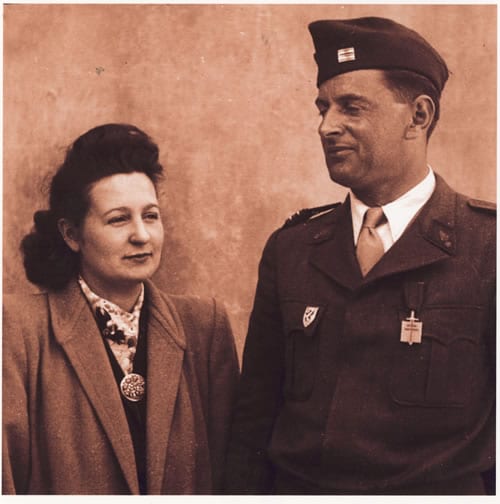Between You and Me: The True Story of a Female French Resistance Fighter
By Leah S. Dunaief

Here is a script for the next Academy Award-winning film whenever we get back to making and viewing movies. It has all the right elements: white-knuckle suspense, bad guys, good guys, some who were both, Nazis, women of courage, men of valor, Charles de Gaulle, a love story, Auschwitz, a close family, children, heartbreak, resilience and especially a tale that truly happened.
What’s it about? It is the life of Cécile Rol-Tanguy before and during WWII.
You probably never heard of her. I hadn’t until I read her obit. She died earlier this month at the age of 101 in Monteaux, 130 miles from Paris. Born Marguerite Marie Cécile Le Bihan April 10, 1919, she was the daughter of Francois, an electrician who served in the French Navy and was a co-founder of the French Communist Party (PCF) in 1920.
Cécile was raised in a highly politicized family that frequently hosted foreign communist agitators on the run from Italy, Germany and eastern European countries. As a communist, her father was arrested for the second time by the Nazis in 1943 and was sent to Auschwitz, where he died.
Cécile dropped out of school in 1936 and got a job with the Comite d’ Aide a la Espagne Republicaine, an organization helping the Republicans against Franco in Spain, and there she met Henri Rol-Tanguy, who was 11 years her senior and a fellow communist. He volunteered to fight in the Spanish Civil War, returned wounded in 1938, and they married in 1939 when she discovered she was pregnant. Sadly, she lost the baby girl in June 1940, two days before Paris fell to the German army. Shortly thereafter her father was arrested for the first time, and her husband, Henri, joined the French Resistance (Forces Francaises de l’Intérieur, or FFI).
Cécile too worked for the resistance, and when she gave birth to a second girl, Henri asked her to work elsewhere and leave the baby with her mother in case both of them were arrested. She refused.
They were separated during the war and were forced to hide their identities and their relationship, only communicating using code names. Cécile would adopt disguises and frequently change her hair style. She moved around Paris often hiding guns, grenades and clandestine newspapers in the baby’s stroller. She worked to set up a command post in an underground shelter, from which the couple received and distributed information and orders. Henri continued to move about the city, but Cécile felt confined to the headquarters, sending out communiques.
Then Aug. 19, 1944, the couple published and distributed a pamphlet calling the citizens of Paris to arms for a general mobilization, and, on Aug. 25, Paris was indeed liberated by the French division of the Allies’ army. In the underground, she said she could not hear the bells but she and the other women there celebrated by having a pillow fight.
Her husband went on to become an officer in the French Army, and while she was initially recognized for her efforts, Cécile felt that the many other women who had participated in the French Resistance at great peril to their lives were not. After the war and throughout the rest of her long life, she represented and advocated for recognition of the role of women in the French Resistance.
After 63 years of marriage, Henri died in 2002, and in 2008, Cécile was asked to become the Grand Officer of the Légion d’Honneur. Reluctant at first, she accepted the great distinction in the name of all the women resistance fighters whom she said were too often forgotten by history.
Cécile Rol-Tanguy died May 8, remarkably on the exact day of the 75th anniversary of the end of WWII in Europe, known as VE Day. As she went along, giving lectures and interviews during her last years, she continually stressed the importance of fighting for one’s freedom. She wanted future generations to receive that message.
Fortunately, she lived long enough to see the reopening of the Musée de la Libération de Paris moved, in August 2019, to Place Denfert-Rochereau, the location of the underground from which she and her husband launched the insurrection that helped in the liberation of Paris.







